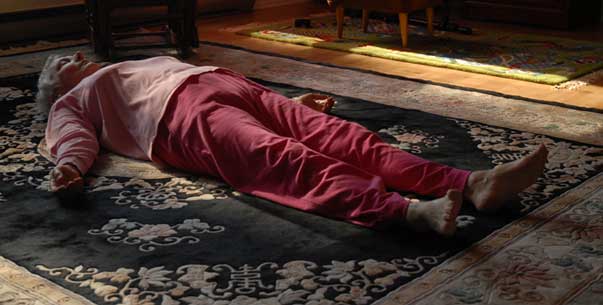|
|
 |
hidden language hatha yoga
the corpse : shavasana
just lying there in savasana
|

photo by charles green
Guest columnist, Karin Lenman has been a student of Swami Radhaís work since 1985, and has been a teacher of Hidden Language Hatha Yoga for 16 years. She lives at Yasodhara Ashram, where she is working on the implications of her brush with cancer, editing text for ashram videos, and teaching Hidden Language.
Swami Lalitananda will return next issue. She has been giving her writing time to the preparation of Swami Radhaís material for an upcoming book, Light and Vibration, to be published in the spring by Timeless Books.
Lying flat on my back, arms a little way out to my side, palms up, fingers gently curled. A perfect Savasana. Only Iím lying on a hospital bed with an intravenous drip in my arm, being wheeled from the surgical recovery room to a ward. Iím just coming to, aware of voices and noise, but with no desire to open my eyes and take part in the commotion. I let it go on around me, feeling uncharacteristically at peace. Everything is in someone elseís hands. Iím lying here, completely at ease. I donít have to do a thing. Itís as close as Iíve come to the yogic ideal of surrender. Iím even in the pose of ultimate surrender, the pose of death. I settle back into feeling held and cared for.
Weeks later, lying flat on my back on the living room floor, I try to recapture that feeling of utter security and trust. How can I achieve it without anesthetic? But then, can anything induced by a drug truly be called surrender? Probably not.
After years of yoga practice, I can get my body to lie still in the corpse pose, but my mind is another matter. There is no way of knowing if the cancer for which I underwent surgery was completely eradicated. I have refused chemotherapy and every now and then the decision surfaces uneasily in my mind. I shy away from those thoughts and instead wonder: How long has anybody to live? What about life that has not yet been lived? What appreciation is there for life and what it has to offer? I have pondered these questions before, but never with such immediacy. I try to wring meaning from them.
Sometimes it seems as if I make no headway with my practice. I keep lying on the floor, and my mind keeps on wandering. I find myself striving for an experience of surrender, yet it eludes me. Nevertheless, I feel positive, even happy, about my life. There is beauty everywhere I look; the people in my life are more dear to me than ever; feelings of gratitude suffuse my heart.
Then one day, I read this: ďThe influence of this pose on the body and the mind Ė from relaxation, to surrender, to death, and even after death Ė is incredible.Ē† And I remember how subtle yoga can be. I remember how years of practising the mantra seemed to have no dramatic effect on my life, and yet the climate of my mind changed almost beyond recognition. And here it is happening again. Day after day of low-key, repeated practice, waiting, just being there in the pose. I surrender my idea of surrender and accept what has been offered.
how to do savasana: the corpse pose
In Savasana, by placing yourself in position, you mentally express your willingness to accept what it offers. The secret of the pose is that you donít do it. There are two ways of positioning the body for Savasana.
option 1
The traditional position from which the pose takes its name is lying flat on the back. Take care to align the body so that it is straight. Let the arms find their place beside the body, usually out a short distance from the hips but not so high as the shoulders. Allow the hands to lie palms up, fingers in their normal relaxed curl Ė a gesture of acceptance. Separate the feet and allow them to roll gently outward, away from each other. (A rolled blanket under the legs, just above or below the knees, may help with lower back discomfort.) Focus your attention lightly on the breath. Say this to yourself two or three times: ďOn each inhalation, awareness expands; on each exhalation, relaxation deepens.Ē Relax.
option 2
Those who have difficulty lying on the back may lie face down with the head turned to one side and the cheek resting on one forearm. To give release to the lower back, one leg can be bent and the knee drawn upward along the floor until it supports the body in a comfortable position. This version is also helpful for women in the later stages of pregnancy. Focus lightly on relaxation with each exhalation.
reflections
1††† Intelligence is perhaps the most intriguing quality of the mind in its aspect of skillful interpreter. Of all the life experiences that have taken place, which were accepted by the mind? Which were rejected or misconstrued?
2††† What would happen if I were to stop the mindís deadly games that kill the goodness in me, the best of my qualities? What would it mean to put to death all the interfering personality aspects that masquerade, deceive and mislead?
3††† How long have I to live? Are there parts of my life that have not yet been lived? How do I want to use the time that remains?
†
Swami Lalitananda's latest book,The Inner Life of Asanas,is a collection of her hidden language hatha yoga columns, from timeless books . She is a resident teacher and part of the collective at radha yoga & eatery - a yoga centre, cafe, arts and events venue at 728 Main Street in Vancouver, BC. Contact her at . radha@telus.net.
|